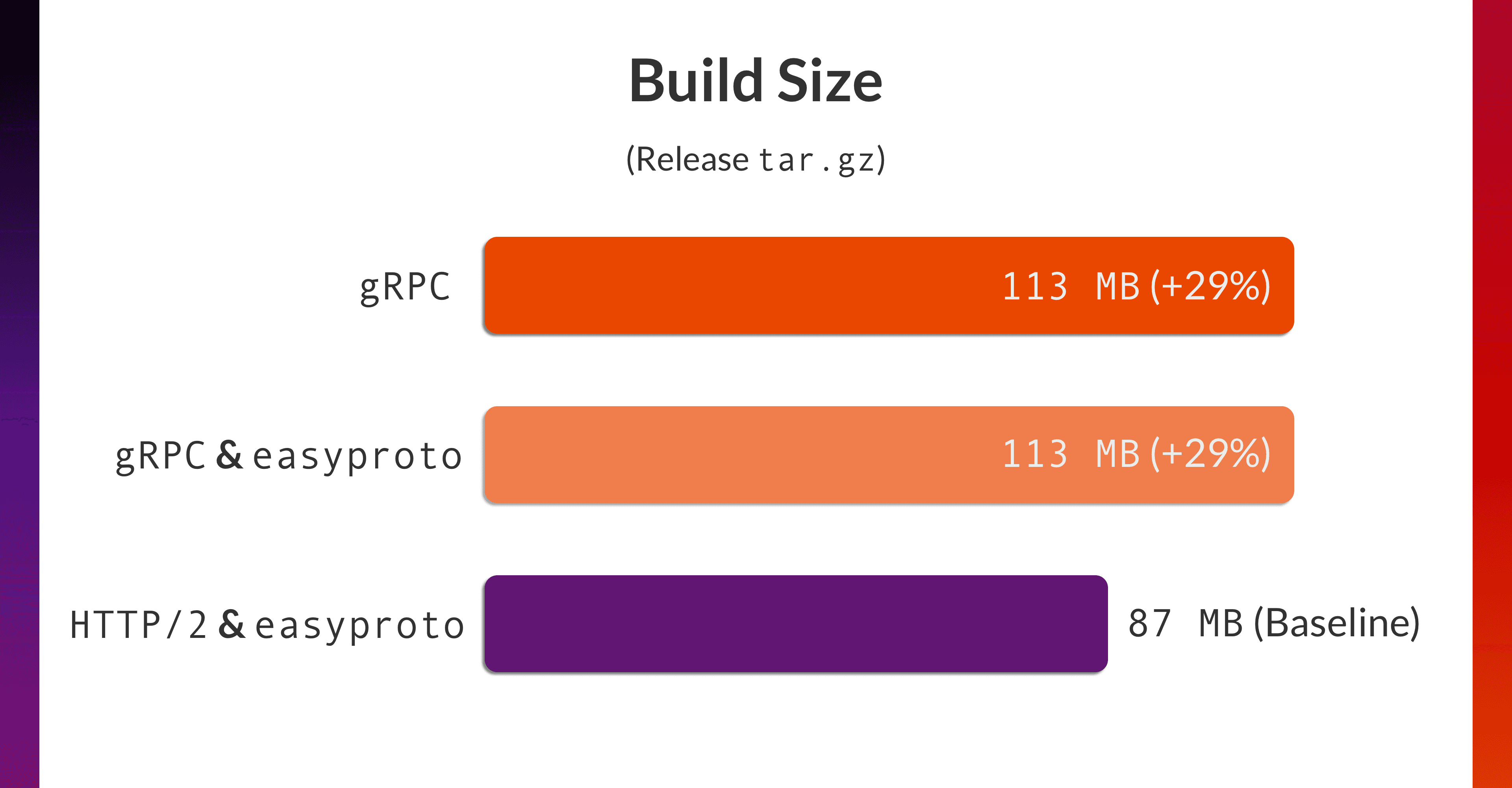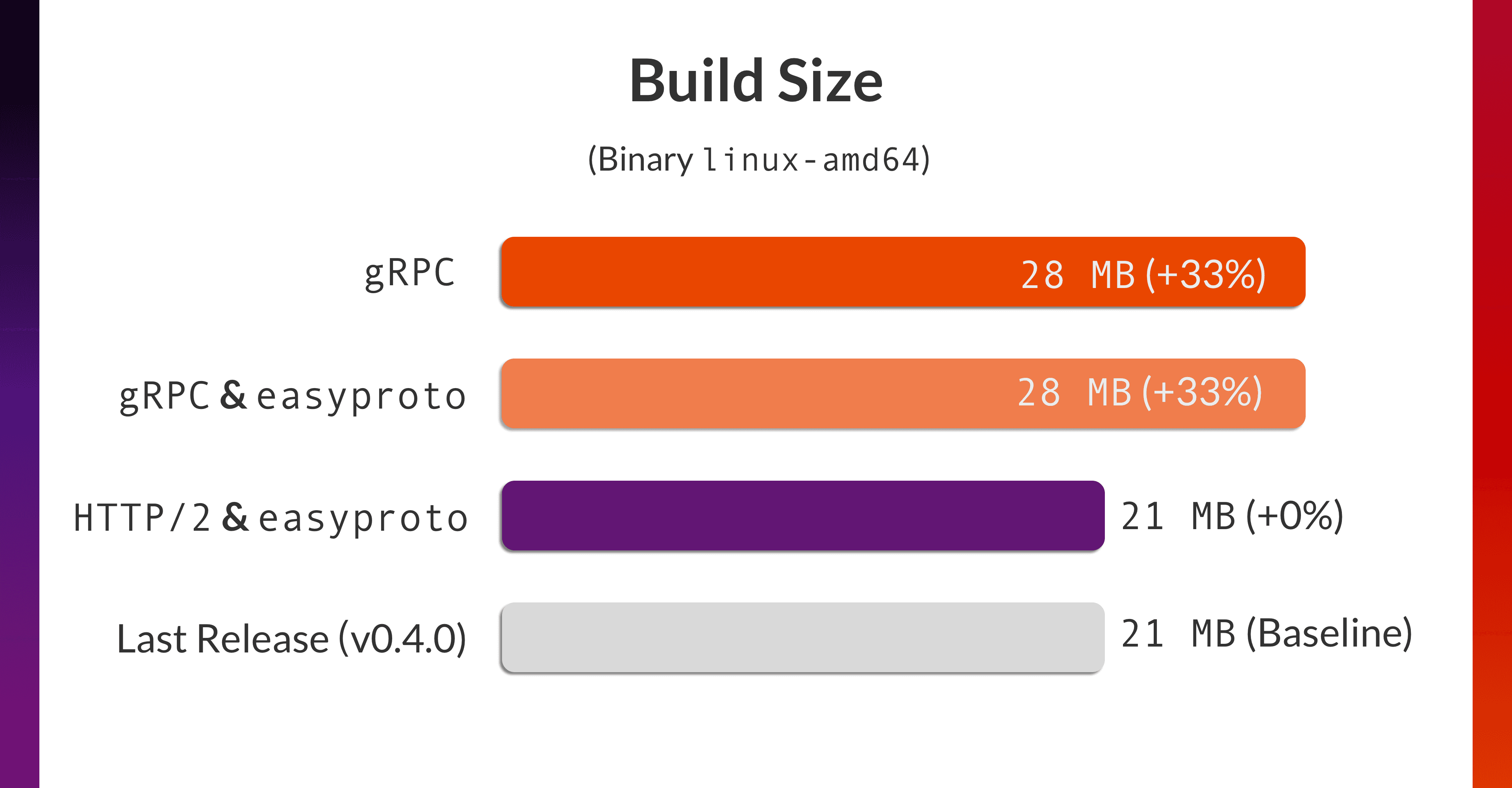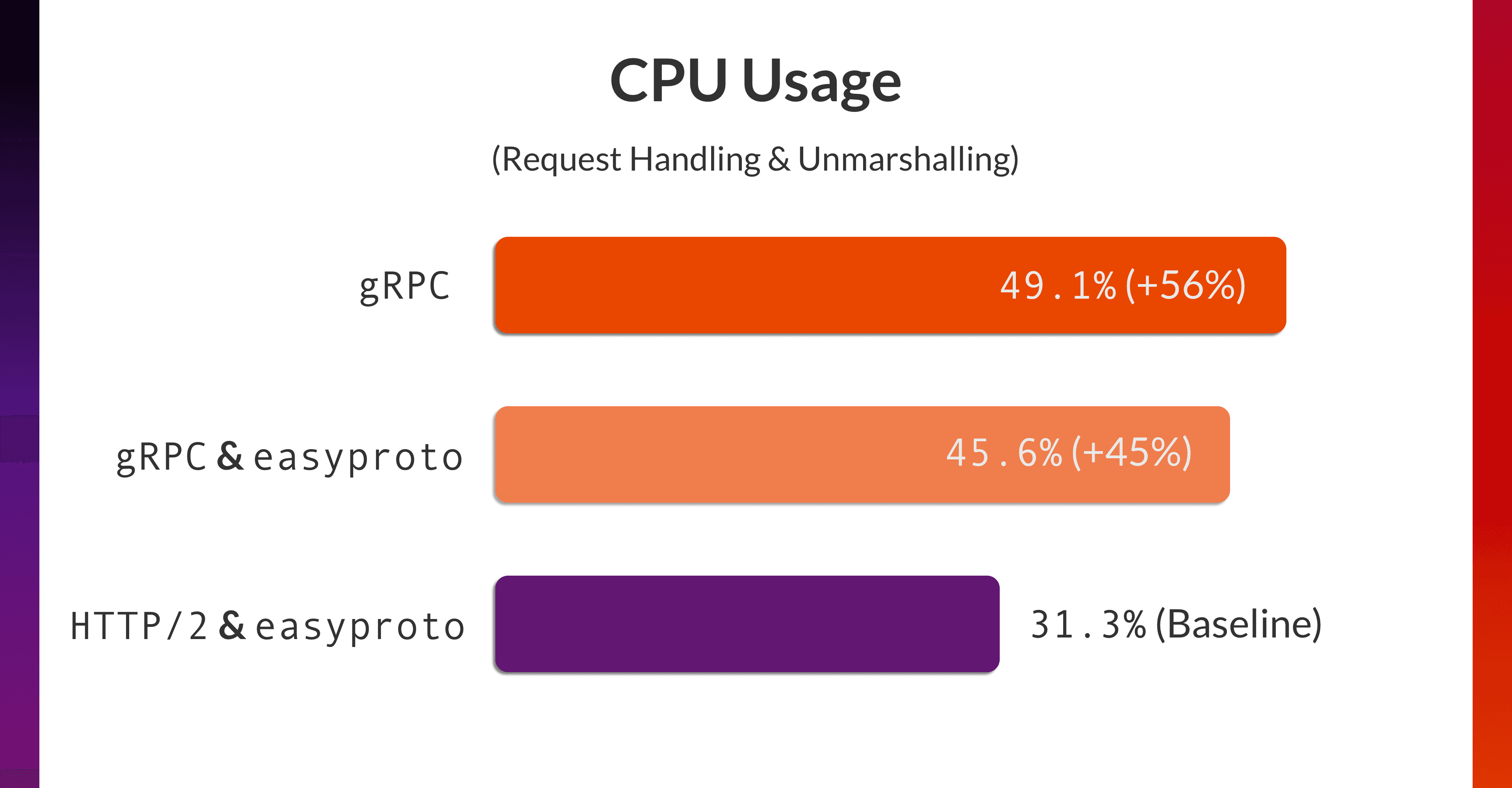- Blog /
- Discarding gRPC-Go: The Story Behind OTLP/gRPC Support in VictoriaTraces

Discarding gRPC-Go: The Story Behind OTLP/gRPC Support in VictoriaTraces
Let’s begin with the results we achieved by discarding the use of gRPC-Go to build the gRPC server for OTLP/gRPC:
- Binary size: -25%
- CPU usage: -36%
Background
#
The OpenTelemetry protocol (OTLP) is very popular for exchanging telemetry data between any OpenTelemetry instrumented applications and OpenTelemetry (compatible) collectors/backends.
Assume you have an application/collector which want to export data to another collector, you can config it to send data with:
- OTLP/gRPC exporter
- OTLP/HTTP exporter, with protobuf payloads encoded in:
- binary format
- JSON format
Currently, VictoriaTraces only exposes an HTTP endpoint to receive data via the latter 2 formats: OTLP/HTTP binary & JSON. There are a lot of applications out there that only support sending data via OTLP/gRPC, one typical example could be kube-apiserver. So it’s important to cover these cases as well.
Supporting OTLP/gRPC
#
The Goal
#
Our goal is to provide a gRPC server that can serve as a TraceService and provide the Export method for invocation,
as defined in the OpenTelemetry’s proto.
// Service that can be used to push spans between one Application instrumented with
// OpenTelemetry and a collector, or between a collector and a central collector (in this
// case spans are sent/received to/from multiple Applications).
service TraceService {
rpc Export(ExportTraceServiceRequest) returns (ExportTraceServiceResponse) {}
}
What makes us consider not using gRPC-Go, or to be more specific, not using the protoc toolchain?
Problem 1: The protoc Toolchain Isn’t User-Friendly
#
The common way to build a gRPC server is:
- Use
protocandprotoc-gen-goto generate thestructs of the messages defined in.proto. - Use
protocandprotoc-gen-go-grpcto generate the service interface defined in.proto.
But, wait. Let’s recall how it could be done. Assume I (who is new to the Protobuf) just cloned the project, and want to add new messages/methods to the .proto:
- Notice that the
protoctoolchain is not part of my Ubuntu/MacOS. - Download the latest version of
protocfrom the release page. - Ooops,
protoccan’t run solely if I want to generate go code. I need togo install protoc-gen-goandgo install protoc-gen-go-grpc. - All set, what’s the commands and flags to generate them? Google “gRPC compile Go” for the tutorial.
- Finally, I prepared the commands and run it locally. Bomb, it said dependency errors, because there are some
imports in my.protoand I have to specify the paths. - After fixing them, rerun the commands and successfully generate (thousands of lines of) Go code.
But don’t jump for joy too soon, because protoc may have unexpected surprises in store for you.
“Why do the new code look different from the previous ones?”
The new one is like:
type TracesData struct {
state protoimpl.MessageState `protogen:"open.v1"`
ResourceSpans []*ResourceSpans `protobuf:"bytes,1,rep,name=resource_spans,json=resourceSpans,proto3" json:"resource_spans,omitempty"`
unknownFields protoimpl.UnknownFields
sizeCache protoimpl.SizeCache
}
While the previous one is like:
type TracesData struct {
ResourceSpans []*ResourceSpans `protobuf:"bytes,1,opt,name=resource_spans,proto3" json:"resource_spans,omitempty"`
XXX_NoUnkeyedLiteral struct{} `json:"-"`
XXX_unrecognized []byte `json:"-"`
XXX_sizecache int32 `json:"-"`
}
- Google for the reason, then redo steps 2-6 using a different version of the
protoctoolchain. (Sometimes you may need togit logto find out who the author of this code.)
All these steps show that compiling protobuf-related stuff is not as straightforward as writing simple HTTP JSON APIs.
It could become easy if you:
- Write commands into the
Makefile. - Use Buf CLI to compile without the
protoctoolchain.
But many developers still opt for the HTTP JSON APIs.
That said, this hardly suffices to persuade us to discard the protoc toolchain. What else?
Problem 2: The Existing Use of easyproto Instead of golang/protobuf
#
Note
Problems 2 may provide further insights, though it should be clarified that it only apply to VictoriaTraces given its unique context.
In VictoriaMetrics, VictoriaLogs and VictoriaTraces, we use easyproto to marshal and unmarshal protobuf messages. The reasons are written in its README:
easyprotodoesn’t requireprotocorgo generate.easyprotodoesn’t increase the binary size unlike traditional protoc-compiled code may do.easyprotoallows writing zero-alloc code.
However, to add OTLP/gRPC support, we need to consider the following:
- If we simply build a gRPC server with code generated by
protoc, how much will the binary size of the application increase? - Can we combine
easyprotowith gRPC? This way,protocwould only need to generate code for the gRPC service, and not for protobuf messagestructs.- Note that this still requires importing gRPC-related packages, which weakens the second reason of using
easyproto(aimed at reducing binary size).
- Note that this still requires importing gRPC-related packages, which weakens the second reason of using
- Are there any other solutions that reuse
easyprotowithout importing new packages?
Unorthodox Way: An HTTP/2 Server
#
The Theory
#
gRPC is a protocol that uses HTTP/2. So it’s possible to implement an HTTP/2 server to serve requests at specific endpoints.
gRPC can also use HTTP/3 (QUIC) and HTTP/1.1, but let’s avoid getting too deep into that for now. Just note that the current implementation also supports gRPC over HTTP/1.1. What’s more, thanks to its highly straightforward design, the OTLP/gRPC JSON format could also be supported very easily. But as the JSON format currently only works with OTLP/HTTP, we haven’t put extra effort into it.
We’ll leave it to readers to explore further.
According to gRPC over HTTP2, the data frame format is like:
// +------------+---------------------------------------------+
// | 1 byte | 4 bytes |
// +------------+---------------------------------------------+
// | Compressed | Message Length |
// | Flag | (uint32) |
// +------------+---------------------------------------------+
// | |
// | Message Data |
// | (variable length) |
// | |
// +----------------------------------------------------------+
And the HTTP endpoint for Export method in TraceService is: /opentelemetry.proto.collector.trace.v1.TraceService/Export.
The following code block shows you how the implementation looks like:
// Init initializes an HTTP server.
func Init() {
logger.Infof("starting OTLP gPRC server at :4317...")
go httpserver.Serve(
[]string{":4317"},
OTLPGRPCRequestHandler,
httpserver.ServeOptions{UseProxyProtocol: nil, DisableBuiltinRoutes: true, EnableHTTP2: true},
)
}
// OTLPGRPCRequestHandler is the router of gRPC requests.
func OTLPGRPCRequestHandler(r *http.Request, w http.ResponseWriter) bool {
switch r.URL.Path {
case `/opentelemetry.proto.collector.trace.v1.TraceService/Export`:
otlpExportTracesHandler(r, w)
default:
grpc.WriteErrorGrpcResponse(w, grpc.StatusCodeUnimplemented, fmt.Sprintf("gRPC method not found: %s", r.URL.Path))
}
return true
}
// otlpExportTracesHandler handles OTLP export traces requests.
func otlpExportTracesHandler(r *http.Request, w http.ResponseWriter) {
// decompression with gzip
...
// verify headers (5 bytes), and unmarshalling the rest bytes with easyproto
...
// presisting data, and more
...
writeExportTraceServiceResponse()
}
The complete code could be found in VictoriaTraces #59.
What’s the Cost
#
While the implementation looks straightforward and simple, there must be a cost.
So far this approach has only been tested with the unary RPC. For streaming RPC, we have no scenarios or motivation for further testing.
This approach can cover what we need for OTLP/gRPC, but it might not work for other cases. If you know more about that, feel free to leave a comment!
Comparison
#
We conduct the benchmark against binary size and resource usage between different approaches of OTLP/gRPC support in VictoriaTraces:
- Write an HTTP/2 server, and unmarshal with
easyproto. - Compile an gRPC server with
protoc, and unmarshal with the native gRPC decoder.
Additionally, the compiled gRPC server does support customizing encoder and decoder via the following code example. We add this to the comparison as well.
import (
"google.golang.org/grpc/encoding"
)
func init() {
encoding.RegisterCodec(&easyProtoCodec{})
}
And here’s the result.
For build size:


And regarding the performance of request handling (CPU usage, no-op: requests are responded immediately after decompressing and unmarshalling):

The monitoring snapshot can be found here. CPU and memory profiles are available here.
Based on the benchmark results, it is evident that HTTP/2 combined with easyproto does demonstrate a clear advantage.
Conclusion
#
This blog shares the story why VictoriaTraces implements gRPC server for OTLP/gRPC in the HTTP/2 + easyproto way.
The core implementation was done by @JayiceZ, with the initial idea coming from @makasim.
There are certain contextual reasons behind this, we’re not try to persuade you to do so. But we see great potential and value, and better developer experience in this approach.
As the VictoriaMetrics Stack aims for high performance and cost efficiency, every bit of saved CPU, memory, and network traffic matters significantly. And the same holds true for binary sizes, Docker image sizes, and other aspects, just as mentioned in this blog by Aliaksandr Valialkin (founder of VictoriaMetrics), and they remain as critical today as they were then.
Leave a comment below or Contact Us if you have any questions!
comments powered by Disqus